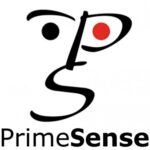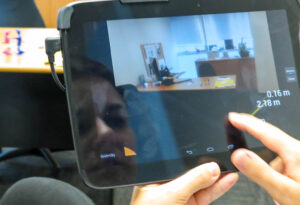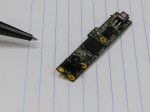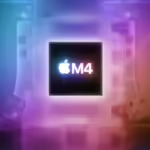Apple has confirmed rumors that it has acquired Israeli semiconductor company PrimeSense. A look at the company’s direction before the acquisition might hold hints for the company’s technology inside Apple.
 Like a guilty couple caught in a hotel room, Apple and Prime Sense have finally admitted to doing a deal after it was prematurely revealed in the Israeli press by Calcalist. Although the companies haven’t revealed the selling price or their plans, the Calcalist story put the number at around $350 million, which, if true, is a bargain considering the opportunities in front of the young Israeli company. On the other hand, Apple is a mighty big bird in the hand and many of the other deals were just sparks in the bush. The PrimeSense principals may have figured a deal with Apple would help them accomplish their ambitions and leave them with money in their pockets. PrimeSense is best known for being the first company to supply technology for Microsoft’s Kinect. Microsoft later bought San Jose-based Canesta to fulfill the company’s ambitions for 3D sensing for cars, TVs, and its game console. Canesta and PrimeSense have similar technology. They’re semiconductor companies that build sensors based on time-of-flight sensing. As luck would have it, JPR was recently in Israel and stopped by PrimeSense for a quick visit. The company gave us their views on the market opportunities they were pursuing and a good time was had by all. So, it was a shock to get home and find out that Apple was in the process of buying the company, though they did tell us “there’s a lot of stuff going on right now.” A slight understatement, as it turns out. But, as these things are in progress few in the company really know what’s up. Calcalist, on the other hand, seems to be pretty well informed. Now that the deal has been confirmed, it’s worth looking at the technologies the PrimeSense people thought were especially promising.
Like a guilty couple caught in a hotel room, Apple and Prime Sense have finally admitted to doing a deal after it was prematurely revealed in the Israeli press by Calcalist. Although the companies haven’t revealed the selling price or their plans, the Calcalist story put the number at around $350 million, which, if true, is a bargain considering the opportunities in front of the young Israeli company. On the other hand, Apple is a mighty big bird in the hand and many of the other deals were just sparks in the bush. The PrimeSense principals may have figured a deal with Apple would help them accomplish their ambitions and leave them with money in their pockets. PrimeSense is best known for being the first company to supply technology for Microsoft’s Kinect. Microsoft later bought San Jose-based Canesta to fulfill the company’s ambitions for 3D sensing for cars, TVs, and its game console. Canesta and PrimeSense have similar technology. They’re semiconductor companies that build sensors based on time-of-flight sensing. As luck would have it, JPR was recently in Israel and stopped by PrimeSense for a quick visit. The company gave us their views on the market opportunities they were pursuing and a good time was had by all. So, it was a shock to get home and find out that Apple was in the process of buying the company, though they did tell us “there’s a lot of stuff going on right now.” A slight understatement, as it turns out. But, as these things are in progress few in the company really know what’s up. Calcalist, on the other hand, seems to be pretty well informed. Now that the deal has been confirmed, it’s worth looking at the technologies the PrimeSense people thought were especially promising.
PrimeSense’ technology
The PrimeSense sensors send out a beam of near-IR light, which is invisible. The sensor picks up the light and audio coming back from the scene, providing depth information to complement the image captured. Now the device has 3D data about the scene giving it more meaning for measurements, augmented reality, reality based games, etc.

APIs for apps
NiTE, PrimeSense’ middleware libraries are built on the company’s OpenNI API. PrimeSense describes their middleware as a thin host, with a minimal CPU load, and multiplatform support. Supplied algorithms use the depth, color, IR and audio information recieved from the hardware device, which enable them to perform functions like hand locating and tracking. A scene analyzer can separate users from background. The software also includes user skeleton joint tracking, various gesture recognition and more. PrimeSense sent OpenNI out into the world as a nort-for-profit consortium in 2010. During our visit to Prime Sense, VP of Marketing Tal Dagan told us the is seeding the market with a lot of apps built for the PrimeSense platform. In addition, it has helped the company build what it feels is the largest base of devices, software, and developers for machine vision. OpenNI has been downloaded by 85,000 people. There are 2000 institions and universities working with it says Dagan and 2 books published with two more to come. A visit to the OpenNI showcase demonstrates just how much work has gone on using the platform. there is a wealth of code available for medical applications, clothes fitting, motion capture, robotics, automotive applications and code for building 3D scanners. What this means for Apple is a well developed network of developers with finished apps, or apps that are well on their way. Gesture for TVS, 3D for phones, smarts for cars The company is working on several fronts including gesture control for TVs, 3D vision for mobile, and third party deals for its sensor modules Carmine and Capri. The Carmine is a larger module, similar to the Kinect, that is used as an add-on module for devices and the technology has been adopted by companies building robots and scanners. In fact, a stand alone version of Carmine is for sale for $200 and PrimeSense says their technology has a solid market base with over 28 million Kinect units sold. However, PrimeSense’ Capri is where the company is putting all its hopes and dreams. It’s a small board designed for embedded applications.

At the time of our visit, PrimeSense said they have customers who plan to incorporate their technology into the TV to enable gesture control. The people at PrimeSense weren’t totally convinced that gesture based input is really going to catch on with the couch-bound. There are no standards so one manufacturer might think a wave should turn on the TV and another might think it means bye-bye and shut the thing down. Also, currently, users have to stand to be recognized, which sort of defeats the whole advantage of gesture based interaction with the TV. After all, just about every improvement to TV input has enabled everyone in the family to maintain their positions on their butts in front of the TV.
PrimeSense does see a lot of benefit for machines that can see who is in the room, who is watching, and who isn’t. If there are kids playing game or adults watching movies. All that information can be useful to show people the content they might be interested in first, or to withhold content not suitable for kids.

The real game that PrimeSense has been interested in is the opportunity of widely used mobile devices and phones. They were working towards a future when every phone and tablet will be gifted with 3D vision enabling more powerful apps. 3D sensing for the automotive industry is a closely related field. The enhancement of 3D sensing for automobiles means more accurate collision detection, augmented parking (please, we need it now), autonomous driving, pedestrian sensing, and more. In all, we’re talking about millions and millions of sensors being sold. Now that Apple has acquired the company we’ll have to wait and see how its technology is incorporated into devices. Most of the reports we’re reading are talking about PrimeSense sensors in Apple TVs. Maybe. If there ever is an Apple TV. The game we refuse to play at JPR is what-will-those-crazy-folks-at-Apple-do-next. It’s a loser’s game. But, just to play a little tiny bit and against our better judgement … we can’t help but believe that PrimeSense’s enthusiasm for the phone is what helped hook Apple into the deal and why Apple thought it was important to buy PrimeSense so its competitors couldn’t have it. PrimeSense had deals cooking on quite a few fronts with different vendors. Apple’s move runs the table and give’s the Cupertino team a clear field to run. Only Microsoft has as much technology stashed in its closets, and at the moment, Microsoft has got some challenges as it tries to determine a strategy and find a new CEO.
The game is never over
Just because Apple has snagged one of the best known companies in the field doesn’t mean it’s game over for the competitors who are as capable of reading the news as we are. The first rumor about PrimeSense being in play came from Calcalist back in July 2013. This is an opportunity for other companies working on the similar technology, and no doubt those companies have been getting phone calls since July. On another front, the Khronos Open API organization has just finalized its OpenVX API for cross platform acceleration of computer vision applications and libraries. This is another pool of active developers who are in the hardware and software business. The existence of an industry standard means that there will not only be devices for these applications, but there will be a segment of devices that work according to the same standard. We’re betting that one of the next major waves that will send us all out to get a new phone is the implementation of 3D sensing in phones.





